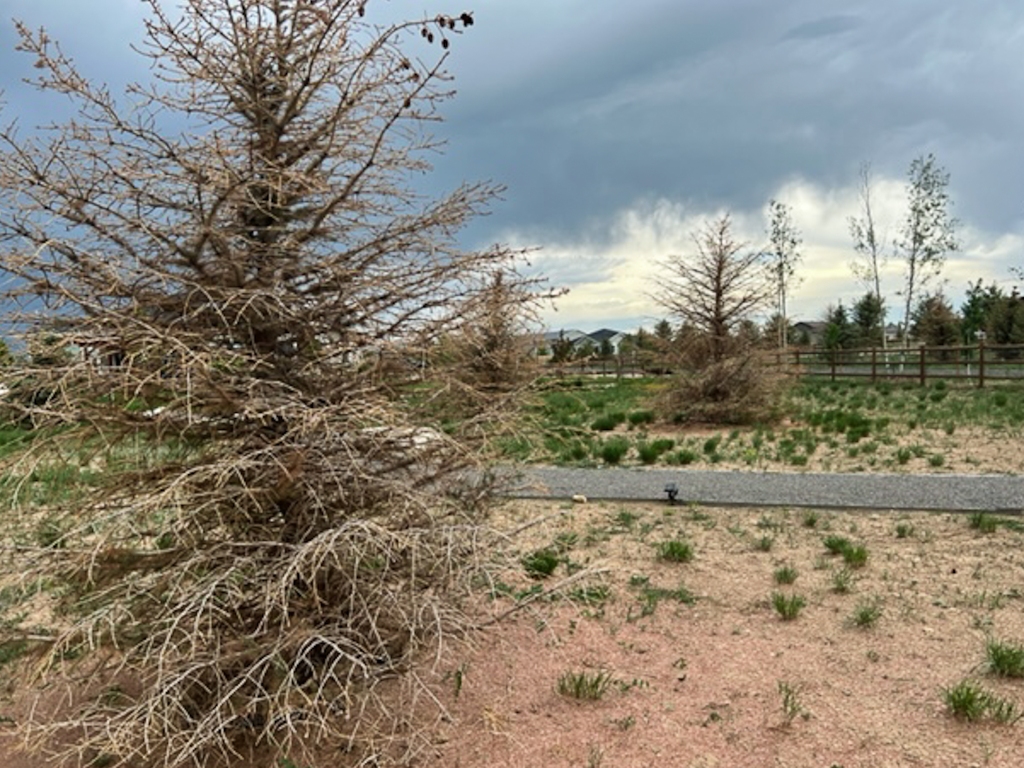
Earlier this year, a homeowner in rural northwest Fort Collins lost 22 evergreen trees over two months.
“I first noticed a problem in early to mid-April,” the homeowner recalls. “The needles turned brown on one tree after another. It was like a cascading, domino effect.”
She noted that brown needles started showing up on the inside of the tree and began working their way outward.
“Each individual tree took three weeks to die, if that,” she adds. “I love trees and the many benefits of trees. I just couldn’t look at them.”
The homeowner called seven arborists. They said couldn’t make it over to her place for weeks or even months, but they offered the usual explanations—not enough water, too much heat, extreme winds. All these factors likely contributed to the trees’ decline. But that wasn’t the real problem, according to the eighth arborist, who took the trees down.
The eighth arborist raised the possibility of pine wilt disease. And he had a cancellation, so he could fit the homeowner into his schedule.
How did the arborist confirm the disease? He cut axial cross-sections (cookies) from the trees. He then showed the homeowner the damage he said was created by pinewood nematodes before he cut down and removed all 22 trees.
“I was devastated,” Soto notes. “It felt like a death. It was a death.”
The only problem is that the trees weren’t pines—they were spruces, according to Colorado State University forestry professor Dr. Seth Davis and professor emeritus Dr. Ned Tisserat, who viewed photos of the trees. Pine wilt nematode doesn’t attack spruces.
When I told Dr. Tisserat that the trees had been planted in holes that weren’t wide enough or deep enough, he said that if the trees were still getting established and were exposed to high winds, drought, and extreme heat, those factors together likely killed the trees. The homeowner said the trees had been in the ground just two years.
However, Dr. Tisserat didn’t rule out the possibility of chemical poisoning because he noticed in the photos that there weren’t weeds or other groundcover around the trees.

We’ll never know for sure how the 22 trees died because the arborist didn’t send tree tissue to CSU’s plant diagnostic lab for analysis.
Mind you, this was a licensed arborist. But he wasn’t certified by the International Society of Arboriculture (ISA), according to my check of his credentials.
The point of all this is to warn you to know who you’re hiring. This poor homeowner got stung twice—first by the green industry “professionals” who planted her trees incorrectly and second by the arborist who apparently doesn’t know a pine tree from a spruce.
I, too, got stung by a so-called professional several years ago when I first moved to Fort Collins and didn’t know anyone. So I followed a recommendation from a neighbor on nextdoor.com and ended up with a landscaper who didn’t know soil amending from mulching.
How do you find a competent green industry professional?
*Check to see if the service provider has certifications. For arborists, check the ISA website, which enables you to find certified arborists and to verify arborists’ credentials in your area, regardless of where you live in the world.
If the arborist isn’t certified, check to see if he/she has a degree or certificate in forestry or a related field.
For landscapers, determine whether the owner or employees hold a landscape management or related degree or certificate from a college or university. I can’t tell you how many times I’ve had to explain to homeowners that the reason their plants are dying is because the landscaping company installed full-sun plants in full shade.
For landscape designers, determine whether they hold a landscape design degree or certificate from a college or university.
*Ask a local, reputable nursery for recommendations. Some nurseries keep a list of screened green industry professionals to help their customers select qualified suppliers.
*Check with your local forestry department to find out if a particular arborist is licensed. A licensed arborist isn’t necessarily ISA-certified, but at least you’ll know whether they’re operating legally in your locality.
If you live in Colorado, be aware that you’ll likely have to wait weeks or months to have a green industry professional work on your property. That’s just the way it is here. Avoid using an unqualified “professional” who happens to be available.
